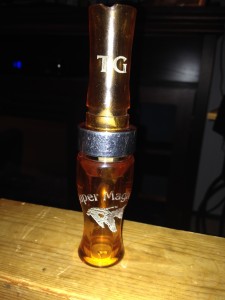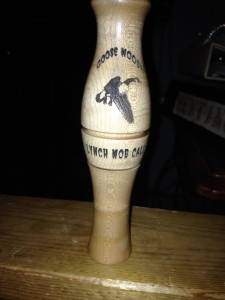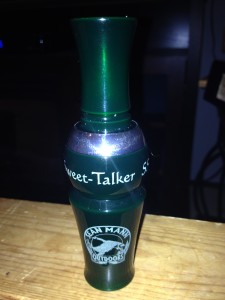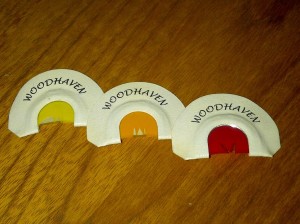The first duck call I ever ran was a wooden single reed Olt that my Dad gave me when I was eight. I finished second in a youth calling contest with it in 1990, but then drifted away from duck calling and into other things during my juvenile and adolescent years. When I dove headlong into waterfowl it was goose hunting that I fell in love with and while most of my disposable income has been funneling its way into goose calls (see the post previous to this for more on that), I’ve long been considering a solid, high quality single reed duck call for my lanyard.
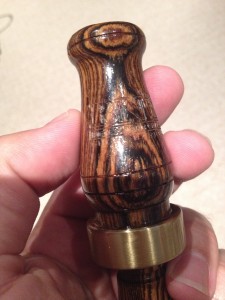
For the last decade or so various average double reed polycarbonate duck calls have worked serviceably on my lanyard and names like Buck Gardner, Knight & Hale, Zink, and Haydel’s have had their chance. They’ve been passable but not without limitations, and this week it was time to move into high-performance territory.
Now this is not to say the above brands were not good calls, and I’ve been particularly fond of my Red Leg mallard from Haydel’s and will likely keep it on my string, but after testing countless calls, I made the move to RNT, and specifically to a single reed Short Barrel in bocote wood. The call is, in a word, impressive. I tried other single reed calls in the RNT line in the lead up to this purchase and two weeks ago I found myself holding an acrylic Daisy Cutter and the bocote Short Barrel in my left and right hands respectively. I was filling the local BassPro store with racket as I sawed away hail calls, single quacks, and feed calls on each one. I ultimately settled on the Short Barrel for reasons I will explain below. As always these are my personal findings and preferences and I’d encourage anyone to do what I did and try out as many calls from as many manufacturers until you find what sounds and works best for your style of calling.
As I said, RNT won the day on this one, and I’ll start by saying that their ‘brand’ definitely had a hand in this decision. Located in the heart of (and some would the epicenter of) southern USA duck country, RNT operates out of Stuttgart, Arkansas which happens to be where the World Duck Calling Championships are held annually (in case you’ve been living under a rock for a while). But more than their location, I’ve always respected their no-nonsense, non-gimmicky approach to waterfowling. These guys just make duck calls and hunt ducks in a straightforward, no BS kind of way and that is appealing to me.
It doesn’t hurt that they churn out some of the purest-sounding duck calls on the market either, and the Short Barrel is no exception.
On first run, it was obvious that this was the call I had to have on my lanyard come this fall. I have a lot of ‘loud’ duck calls so windy day range or aggressive hail calling was not something I was worried about; instead I wanted something a little more true sounding for close-in work and finesse, and that is something the Short Barrel has in spades. The compact size and mellow sound of the wood puts a smooth edge on the mid-range and soft quacks, while feed calls roll out of this little call with ease. It can still get loud, but not in that ringing, nasty-edged way that an acrylic call would be apt to. The risk here is that when blown too hard, this call does seem to squeak and lock up. In short it requires a lighter touch than I may be used to, so of course practice has been the key for the last few weeks.
The call is new but even now it is surprisingly responsive, so I’m chomping at the bit to hear how it sounds once I’ve broken bit in somewhat. As it stands currently, this call descends down a five note scale cleanly, and changes speeds with only the most subtle variations in air pressure. Speaking of pressure, absolutely no back pressure is required to run this call through all the sounds a hunter would require; the mellow tone of the bocote softens the feed calls and quacks nicely. I have found that applying back pressure only muffles the resonance that the Short Barrel has naturally built into it.
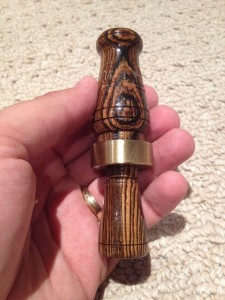
Now of course, the sound is the key here, but it should be noted that the Short Barrel in bocote looks damn sexy as well. The wood has a dark chocolate grain that runs through a caramel-colored body and the call is completed with a low-gloss band. I have also always loved the smell of wooden duck calls and this one is no different; something about the smell of wood call takes me back to my childhood of learning to call ducks on Dad’s classic Olt call.
Since it is the off-season right now, the one part missing from this review is field performance, but that just means in a month or so I get to write about this call again, so that’s a plus. In the meantime, I’ll just be sitting in the basement, practicing and rasping away on this new toy of mine and waiting for the October morning when I get to slide on my waders, find an out of the way spot in the long grass, and wait for the whistling of mallard wings.
When it happens, I think the Short Barrel will be ready for the spotlight.

